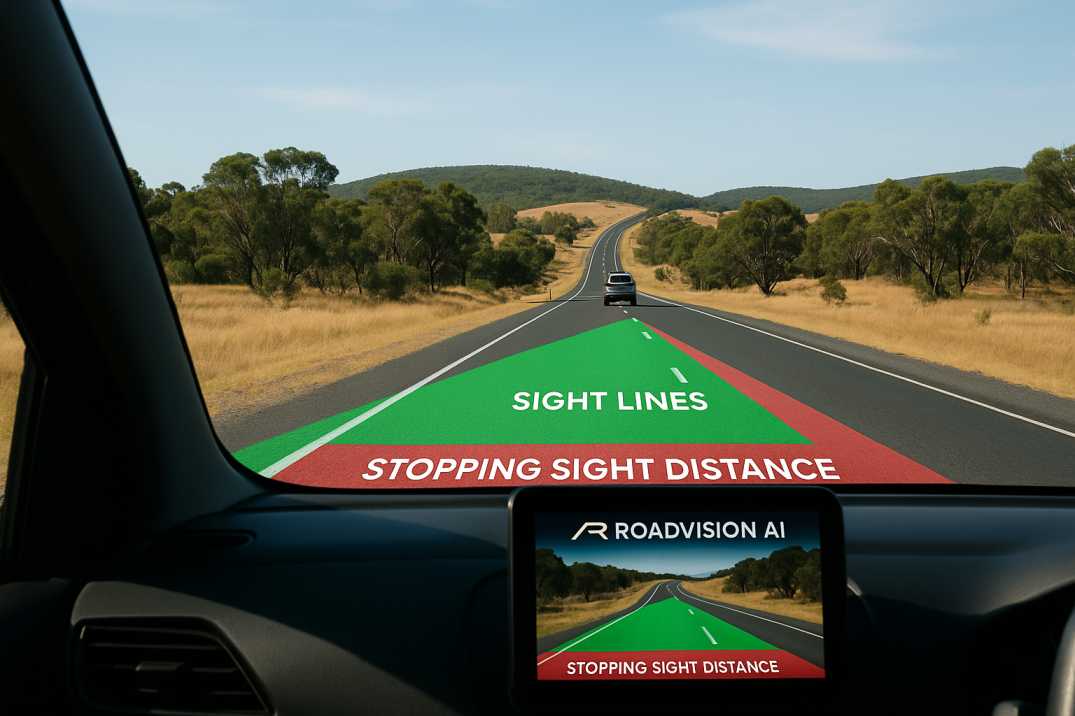Contact Us
RoadVision AI
Private Limited
Office No. 308 & 310, B Block
Ansal Chamber - 1, Bhikaji Cama Place,
Near Engineers India Limited (EIL) Bhawan, New Delhi - 110066
© 2024 | RoadVision AI | All rights reserved
In modern road design, ensuring adequate sight distance is fundamental for safety and performance. Sight distance influences everything from speed limits to accident risk. According to Austroads road design standards, failing to meet minimum sight distance requirements—especially at curves, crests, and intersections—can lead to increased crash potential and non-compliance with design codes.
Today, AI-based road asset management is transforming how sight distances are measured, verified, and enforced. Through advanced image analysis, spatial mapping, and real-time compliance audits, AI tools such as RoadVision AI are helping engineers and agencies deliver safer and smarter road infrastructure.

Sight distance refers to the length of road ahead visible to a driver. Austroads defines multiple types of sight distance:
As per the Austroads Guide to Road Design, these parameters are determined by:
Failure to meet these criteria can result in substandard design—a condition frequently flagged during road safety audits and compliance inspections.
According to AGRD Part 1 & 2, minimum sight distances must be ensured for:
For instance, AGRD01-21 notes that substandard sight distance is often found at:
When these conditions exist, Austroads recommends using Extended Design Domain (EDD) values sparingly, and only when fully justified.
Traditionally, sight distance measurements require:
This method is time-consuming, costly, and lacks standardization. Moreover, many rural or older roads in Australia were built under older design philosophies and are prone to non-compliance—especially with growing traffic speeds and new vehicle dynamics.
This is where AI in road inspection comes in. Platforms like RoadVision AI bring automation, accuracy, and scale to the process of sight distance verification.
In regional Australia, RoadVision AI has been deployed to inspect hundreds of kilometers of rural highways where traditional inspections are too resource-intensive.
By applying its AI-powered dashboard cameras, RoadVision created:
This has led to improved safety planning and faster approvals from transport authorities.
With growing complexity in urban road layouts and higher-speed rural corridors, real-time and remote sight distance auditing will soon become a norm. Digital twin models of highways combined with AI-enabled audits are enabling:
For municipalities, state departments, and engineering consultants, these tools are a game-changer in ensuring road safety without overburdening budgets.
Sight distance may seem like a simple geometric concept, but it is the foundation of safe road design. Ensuring it across all segments—curves, crests, intersections—is non-negotiable for Austroads compliance and public safety.
By embracing AI-based road asset management systems like RoadVision AI, agencies can:
RoadVision AI is revolutionizing roads AI and transforming infrastructure development and maintenance with its innovative solutions in AI in roads. By leveraging Artificial Intelligence, digital twin technology, and advanced computer vision, the platform conducts thorough road safety audits, ensuring the early detection of potholes and other surface issues for timely repairs and improved road conditions. The integration of potholes detection and data-driven insights through AI also enhances traffic surveys, addressing congestion and optimizing road usage. Focused on creating smarter roads, RoadVision AI ensures compliance with Austroads geometric design guidelines and IRC Codes, empowering engineers and stakeholders to reduce costs, minimize risks, and elevate road safety and transportation efficiency.
Ready to see how RoadVision AI can help you verify road compliance effortlessly? Book a demo with us
Q1. What is the minimum sight distance in road design?
It depends on design speed, road gradient, and type of maneuver. Austroads provides specific SSD, ISD, and OSD values based on these parameters.
Q2. How does AI calculate sight distance?
AI systems use video and lidar inputs to simulate driver vision and detect line-of-sight constraints over road geometry.
Q3. Is AI inspection approved under Austroads guidelines?
AI outputs can be used to support design reviews, digital audits, and are increasingly accepted in road safety verification processes.